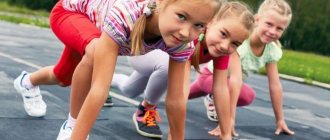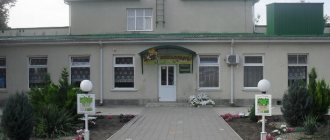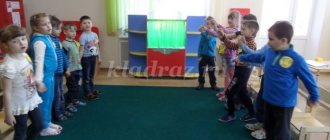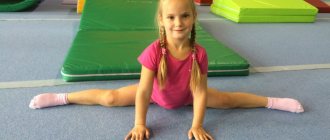Proper nutrition
Nutrition is a means of maintaining life, growth and development, health and high performance of a person.
Poor nutrition leads to metabolic disorders and disruption of the functional state of body systems. "What is proper nutrition"
Proper nutrition - the presence of all the necessary nutrients in the menu. Proper nutrition is a balanced diet with all the necessary substances, carbohydrates and fiber, the required amount of vitamins, minerals and microelements. Proper nutrition means limiting the intake of harmful substances.
You need to start limiting yourself from more harmful to less harmful.
Basic principles of proper nutrition
1. The energy value of food must correspond to the energy expenditure of the body. 2. Balanced diet, i.e. compliance of the chemical composition of nutrients with the physiological needs of the body. 3. Mode. Proper diet
Science has accumulated a lot of information about proper nutrition, but not everyone knows it. Every person needs to know several postulates about proper nutrition:
- take food often in small quantities;
- avoid long periods between meals;
- the chemical composition of food must be completely broken down by the body's enzymes;
- It is recommended to have dinner no later than three hours before going to bed;
- There must be a balance of proteins, fats, carbohydrates
- the diet should contain a large amount of vegetables and fruits
Physical activity
Motor activity is understood as the sum of all movements made by a person in the process of his life. This is an effective means of maintaining and strengthening health, harmonious personal development, and disease prevention. An indispensable component of physical activity is regular physical education and sports. Physical activity has a beneficial effect on the formation and development of all functions of the central nervous system: strength, mobility and balance of nervous processes.
Systematic training makes muscles stronger, and the body as a whole is more adapted to environmental conditions. Under the influence of muscle loads, the heart rate increases, the heart muscle contracts more strongly, and blood pressure rises. This leads to functional improvement of the circulatory system.
During muscle work, the breathing rate increases, inhalation deepens, exhalation intensifies, and the ventilation capacity of the lungs improves. Intensive full expansion of the lungs eliminates congestion in them and serves as a prevention of possible diseases.
Physical activity is a leading factor in human health, because is aimed at stimulating the body's defenses and increasing health potential. Full physical activity is an integral part of a healthy lifestyle, influencing almost all aspects of human life.
Project activities on healthy lifestyle “I want to be healthy”
ANNA SOSHNIKOVA
Project activities on healthy lifestyle “I want to be healthy”
Project “I want to be healthy ”
Authors of the project : educators Soshnikova A.V., Sukhinina S.S.
Project participants : pupils of preparatory group No. 1
Project location : group No. 1
Project type :
according to the leading method: practice-oriented.
by the nature of the project : children and sports.
by the nature of contacts: within the same group.
by number of participants: group.
duration short-term, 1 week (April)
.
by the nature of the child’s participation in the project : performer.
Project goal : To develop preschoolers' interest in a healthy lifestyle .
Project objectives :
-increase children’s interest in a healthy lifestyle through various forms and methods of physical education and health work ;
-continue to introduce children to the rules of hygiene;
-contribute to the strengthening of health through a system of health-improving activities ;
-increase the pedagogical competence of parents on the issue
maintaining and strengthening the child's health ; propaganda in the development of the need to be healthy and lead a healthy lifestyle .
-instilling interest in different sports through cognitive activity ;
-motivation to maintain a healthy lifestyle within the project and outside of it ;
- education of moral behavior;
-introduction of health-saving technologies into the educational process. ;
-organization of a health-preserving environment for the beneficial physical development of children.
Relevance of the project . In preschool childhood, the foundation of a child’s health a healthy lifestyle is impossible .
Helping children recognize and learn to understand the importance of health was the reason for creating this project .
the project aims to solve .
It is very important today to develop in preschool children motives, concepts, and beliefs in the need to preserve their health and strengthen it by introducing them to a healthy and safe lifestyle. The significance of the application of this work is determined by solving the problems of improving the health of preschool children , fostering a culture of safe and healthy lifestyle - creating a solid foundation for raising a healthy child
Activities : _
Cognitive, playful, artistic - creative, communicative, musical, motor.
Project support :
— materials for conducting interviews;
-materials with poems, riddles, stories;
- illustrations depicting different sports, products containing healthy vitamins;
— cut pictures;
- works of art;
- coloring books,
-plasticine,
- means of TSO, ICT;
- audio recordings of songs.
Expected result: maintaining and strengthening the health of children through a system of comprehensive physical education and health work ;
Creation of a subject-based developmental environment that ensures the effectiveness of health-improving work ;
Using various forms of interaction with parents
in order to increase the level of knowledge on the issue of strengthening and
maintaining children's health .
products for children :
-physical education and health event “Fun Starts”
.
-making an album about various sports
-release of a wall newspaper with families: “How I play sports!”
- replenishment of the card index of outdoor and didactic games;
Stages of project activity
Stage 1 (preparatory)
:
— determination of the current significance of the project ;
- determination of children’s knowledge about a healthy lifestyle ,
-setting goals and objectives;
-selection of methodological literature and visual and didactic material for the implementation of the project ;
— organizing and equipping a subject-spatial development environment in the group.
Activities of a teacher:
1. Creation of a developmental environment.
2. GCD of the cognitive cycle, reading fiction, looking at encyclopedias, watching presentations on the topic;
3. GCD of productive activity : applique, modeling, drawing;
4. Game activities : outdoor, didactic games, game situations, problem situations created by the teacher;
5.
— Working with parents:
— survey of parents “ Healthy lifestyle ”
— consultation “The role of the family in the formation of a healthy lifestyle”
;
“The role of sports in family education”
;
— Conversation: “The importance of a healthy lifestyle for human health ”
.
- involvement in the production of an album about various sports; wall newspapers with families: “How I play sports!”
— involving parents in the final event “Fun Starts”
;
— moving folder “ Healthy child ”
.
Children's activities
2. Selection of methodological and fiction literature on the topic.
3. Development of classes and an action plan on the project .
4. Reading and viewing fiction, encyclopedias.
5. Watching cartoons “Moidodyr”
, from the series
“Lessons from Aunt Owl”
.
6. Conducting didactic and verbal games with children.
7. Productive activities : modeling, drawing, appliqué.
8. Dynamic pauses, active and sports games, relaxation, finger exercises, eye exercises, breathing exercises, after-sleep exercises.
9. Replenishment of the subject-developmental environment of the group.
The project implementation took place through different types of activities
Stage 2 (main)
Cognitive - practical activities :
Work plan for project
Goals and objectives Events, content of work
1 Topic of the day: health hides ”
*Continue to develop an interest in your own body, well-being related to your health .
*Satisfy children's need for physical activity.
*Develop running speed, agility, and attention.
*Draw the attention of parents to the fact that, depending on the season and weather, a dressed child is less susceptible to colds *Morning exercises “Moidodyr exercises”
;
*NOD “Journey to the Land of Health ”
;
*Didactic game “What is healthy to eat and what is harmful”
;
*Reading: A. Barto “The Dirty Girl”
, S. Semenov
“How to become a non-sick person”
,
Walk: running games "Quickly pick up, quickly put down"
, games with jumping
“Frog and Herons”
, games with throwing and catching
“Whoever is named, he catches”
;
Afternoon:
* Role-playing game “Healthy Food Store”
;
*Didactic game: “The ABC of Vitamins”
.
Working with parents:
design of the folder – movement “ Healthy Child ”
.
2 Topic of the day: “ Healthy teeth ”
* Explain to children the cause of dental disease;
*Form the habit of brushing your teeth;
*Teach your child to be attentive to himself and the condition of his teeth;
*Develop children's coordination of movements, strength, agility, endurance"
*Draw the attention of parents to sports in their family - going to the stadium, swimming pool, gym, etc.” * Morning exercises “Moidodyr exercises”
;
*Conversation “ Healthy teeth ”
;
*Reading the fairy tale “The Tale of the Toothbrush”
;
*Didactic game: “What is harmful and what is good for teeth”
;
"Find out by taste"
. Guessing riddles.
*Productive activity : Drawing. “A toothbrush for the boy Petya”
;
Walk:
Afternoon:
Experience: “What can happen to our teeth if we don’t take care of them?”
.
Work with parents: conduct a survey of parents “The role of sports in family education”
;
3 Topic of the day: “Moidodyr”
*Formation in children of ideas about the rules of personal hygiene;
*Give children a basic understanding of infectious diseases and their causative agents (germs and viruses)
;
*Continuation
educational advisory activities with parents on the development of children’s interest in leading a healthy lifestyle (sport is an integral part of it)
;
* Morning exercises “Moidodyr exercises”
;
Conversation “Microbes and Viruses”
.
*Didactic game “Personal hygiene items”
;
*Reading: Nursery rhymes, poems, riddles on a given topic.
*Finger gymnastics “Wash your hands clean - clean”
;
Breathing exercises: “Dandelion”
.
Walk: Outdoor games:
"Catch a tail"
.
“Catch a mosquito”
,
“Hide and seek”
.
Communication situation: “Is it good to walk outside?”
.
Afternoon:
Watching the cartoon "Moidodyr"
K. Chukovsky.
Working with parents:
Conduct a conversation based on the results of the survey, introduce parents to their children’s answers to the same questions.
4 Topic of the day: “ Healthy eating .” Vitamins"
*Expand and clarify children’s knowledge about the presence of vitamins in fruits and vegetables;
*Create conditions for children to develop ideas about healthy products on our table;
*Help create motivation in children and parents to develop a healthy lifestyle *Morning exercises “Moidodyr exercises”
;
*GCD "Vitamins and healthy products"
;
Physical school
.
*Learning poems, riddles, nursery rhymes;
*D/i: Health Pyramid ”
,
“Make no mistake”
, dominoes
“Vegetables and fruits are healthy foods”
.
Walk: small games. sub "Edible - inedible"
.
P/n: “Don’t get caught”
Afternoon: Watching the film “Charging”
from the m/f series
“Luntik”
.
*Didactic game “Healthy and unhealthy food”
;
Physical school
.
5 Topic of the day: “We are always friends with sports”
*Form a stable habit of physical activity, interest and need for physical self-improvement;
*Cultivate a desire to achieve success in sports and various competitions;
*Inform parents about the results of the past health (wall newspaper about the events of the health )
;
* Morning exercises “ “Yes”
to health ;
Breathing exercises “Geese are flying”
.
*Looking at illustrations about various sports;
D/i: lotto “Sports”
.
Reading the work of A. Kutafin “Vovka’s Victory”
.
Productive activity : Construction: “Sports ground”
.
Walk: outdoor games:
"Rabbits"
;
"On a level path"
;
“Run to the flag”
»
“Get into the circle”
;
Afternoon: Gymnastics after sleep “Pinocchio stretched...”
.
Sports entertainment “Fun Starts”
.
Working with parents:
Conversation: “The importance of a healthy lifestyle for human health ”
.
Stage 3 (final)
-Designing the result of the project with various sports.
-presentation of the project product to children and parents .
-presentation of the project at the pedagogical council at the preschool educational institution.
The result of the project : children have significantly increased interest and desire to do gymnastics, physical education, take part in health procedures , and knowledge about the importance of a healthy lifestyle .
The idea of health-improving activities .
Perspective:
The project is the result of the creative activity of children , parents, and the teaching staff of the group.
As a result of this project , an effective system of work has been created to preserve and strengthen the health of children and introduce them to a healthy lifestyle , both in the group and at home. health into teaching practice aimed at protecting and strengthening the health of preschool children . The project can be implemented in any preschool educational institution.
Personal hygiene
Personal hygiene is an integral part of human culture. It is the conscious observance of the rules of personal hygiene that distinguishes each of us from animals.
Personal hygiene is a set of hygienic rules, the implementation of which helps to preserve and strengthen human health. Personal hygiene includes general hygienic rules that are the same for people of any age: proper alternation of mental and physical labor, physical education, regular meals of nutritious food, alternation of work and active rest, adequate sleep. Personal hygiene in the narrow sense includes hygienic requirements for keeping the body, linen, clothing, home clean, as well as maintaining cleanliness when preparing food. The first priority is to maintain cleanliness of the body.
One of the most important tenets of personal hygiene is skin care. This must be done not only for an attractive appearance, but also for health.
The skin is one of the largest organs in the human body. Moreover, the skin is one of the first places in the body in terms of the number of functions it performs. So, the skin is responsible for thermoregulation, oxygen enters the body through it, nutrients enter the blood through the skin, the skin is the most important of the senses. A healthy person has clean and smooth skin. The appearance of any pimples, redness or ulcerations on the skin indicates a problem with the whole body. Therefore, it is necessary to constantly monitor the condition of your skin.
It is necessary to take a warm shower daily using a hard washcloth and soap. Do not wear underwear that is dirty or unwashed. Do not try to open abscesses or crush acne yourself. You need to choose underwear and clothes from comfortable materials. It may not necessarily be pure cotton; many modern materials are not inferior to cotton in all respects. When going out into severe frost, wear mittens and treat exposed skin with special fatty creams.
Oral hygiene is a very important component of personal hygiene. If your teeth are not in order, then the whole body suffers. If there are foci of caries in the mouth, with periodontitis or periodontal disease, the infection easily spreads to the sinuses, tonsils, and kidneys. Therefore, brush your teeth regularly twice a day. To do this, use a toothpaste and brush that suits you. If you do not have the opportunity to brush your teeth after your next meal, rinse your mouth, at least with clean water. It is advisable to remove food debris using dental floss or a toothpick. You should visit the dentist once every six months.
Personal hygiene is impossible without hair hygiene. Wash your hair as often as necessary to keep it clean. It’s just important to choose the shampoo. If your hair is so oily that it needs to be washed daily, you need to find a shampoo for daily use. Do not comb your hair while wet, do not use metal combs for this.
Project “Healthy Lifestyle”
Project
on the topic: “Healthy lifestyle” Authors: Sivak G V
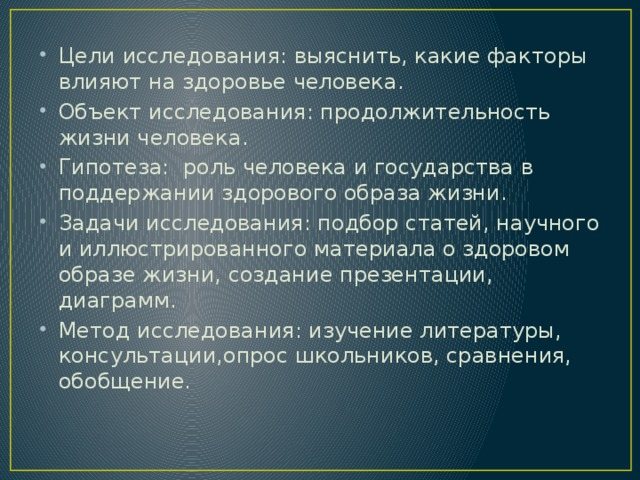
- Objectives of the study: to find out what factors influence human health.
- Object of study: human life expectancy.
- Hypothesis: the role of the individual and the state in maintaining a healthy lifestyle.
- Research objectives: selection of articles, scientific and illustrated material about a healthy lifestyle, creation of presentations, diagrams.
- Research method: literature study, consultations, survey of schoolchildren, comparisons, generalization.
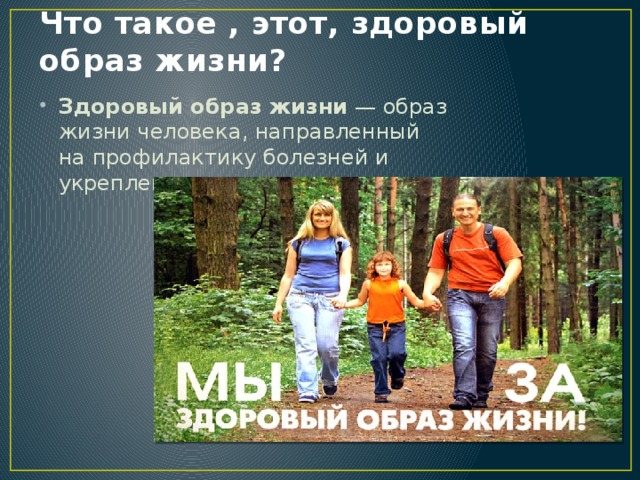
What is this healthy lifestyle?
- A healthy lifestyle
is a person’s way of life aimed at preventing diseases and promoting health.
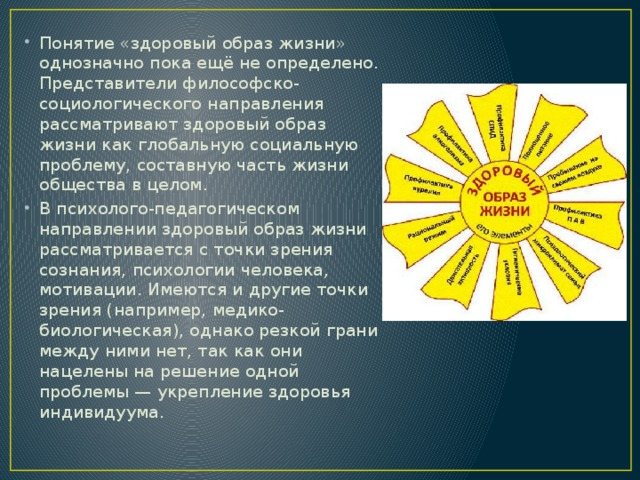
- The concept of “healthy lifestyle” has not yet been clearly defined. Representatives of the philosophical and sociological school consider a healthy lifestyle as a global social problem, an integral part of the life of society as a whole.
- In the psychological and pedagogical direction, a healthy lifestyle is considered from the point of view of consciousness, human psychology, and motivation. There are other points of view (for example, medical and biological), but there is no sharp line between them, since they are aimed at solving one problem - improving the health of the individual.
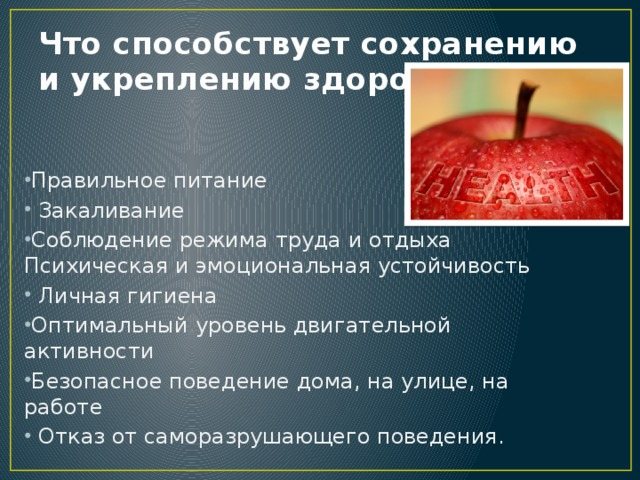
What helps maintain and improve health:
- Proper nutrition
- Hardening
- Compliance with work and rest schedule Mental and emotional stability
- Personal hygiene
- Optimal level of physical activity
- Safe behavior at home, on the street, at work
- Avoiding self-destructive behavior.
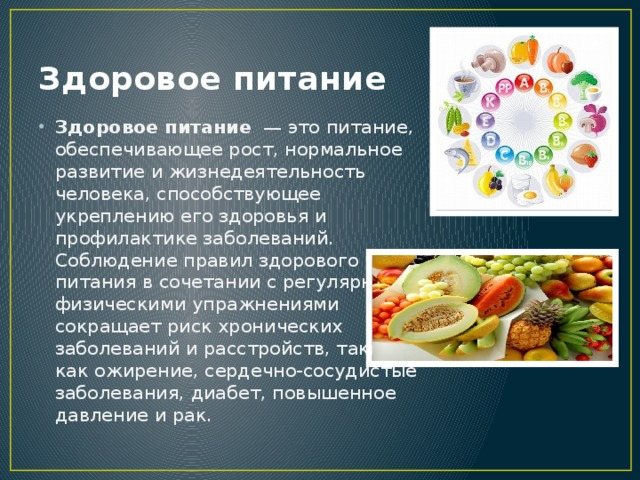
Healthy eating
- Healthy nutrition
is nutrition that ensures growth, normal development and vital activity of a person, promoting his health and preventing diseases. Following a healthy diet coupled with regular exercise reduces the risk of chronic diseases and disorders such as obesity, cardiovascular disease, diabetes, high blood pressure and cancer.
Proper nutrition.
- Strict adherence to the rhythm of eating. Unlearn to satiate yourself with food to the limit. Food should be eaten with attention and pleasure, slowly chewed and tasted.
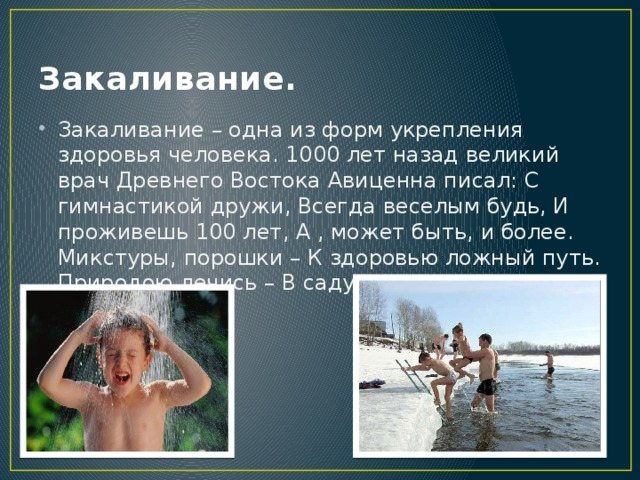
Hardening.
- Hardening is one of the forms of strengthening human health. 1000 years ago, the great doctor of the Ancient East, Avicenna, wrote: Be friends with gymnastics, Always be cheerful, And you will live 100 years, And maybe more. Potions, powders - the wrong path to health. Heal yourself with nature - in the garden and open field.
A person’s physiological state is greatly influenced by his psycho-emotional state. Therefore, some authors also highlight the following additional aspects of a healthy lifestyle:
emotional well-being: mental hygiene, the ability to cope with one’s own emotions and problems;
intellectual well-being: a person's ability to learn and use new information to perform optimally in new circumstances. Positive thinking.
spiritual well-being: the ability to set, strive for, and achieve truly meaningful, constructive life goals. Optimism.
Some researchers also highlight “social well-being” - the ability to interact with other people.
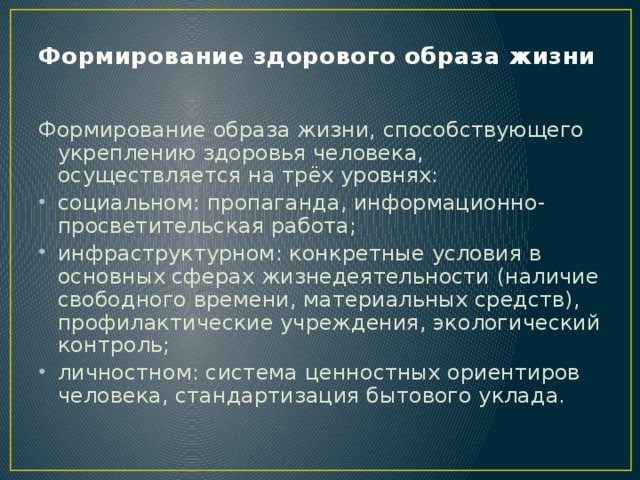
Formation of a healthy lifestyle
The formation of a lifestyle that promotes human health is carried out at three levels:
- social: propaganda, outreach;
- infrastructural: specific conditions in the main spheres of life (availability of free time, material resources), preventive institutions, environmental control;
- personal: a system of human value guidelines, standardization of everyday life.
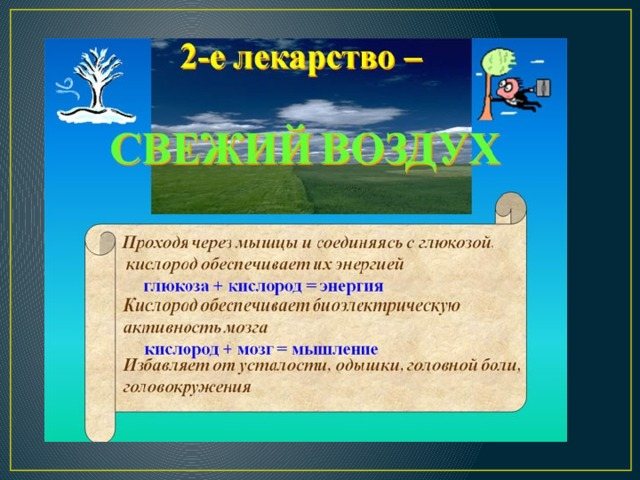
Human life expectancy in different countries

Japan.~
- Average life expectancy
in Japan - 82 years old.
- Today it is no longer a secret that the Japanese are the longest-living nation on earth. Their average life expectancy is constantly increasing and in 2011 it already reached 79 years for men and 86 years for women. The Japanese are not only world champions in longevity, they are the healthiest nation on earth
12 rules for health and longevity from Japan:
1. Follow the following rule of Hara hati bumne: eat until you are 80% full.
- 2. Watch your portion sizes: put food on a small but beautiful plate.
- 3. Chew your food slowly, savoring every bite.
- 4. Get into the habit of decorating your dishes beautifully.
- 5. Eat more fish, fresh fruits and vegetables and less saturated fat.
- 6. Cook with canola oil or rice bran oil.
- 7. Teach yourself to have breakfast like the Japanese, and not snack on sandwiches.
- 8. Let red meat be a rare exception to the main dish with vegetables.
- 9. Instead of bread and rolls, eat a serving of white or, better yet, brown rice.
- 10. Avoid sweet carbonated water; it is better to drink iced Japanese tea without sugar and plain water.
- 11. Walk as often and as long as possible.
- 12. Don’t forget, an important component of a healthy lifestyle is the love of food, so preparing and eating food should bring you pleasure.

Singapore.
In addition to prosperity, Singapore has a high life expectancy. In the early 1980s, the government recognized that the average age of citizens was rising. The government has planned programs to increase medical facilities, and Singapore currently has excellent medical facilities

San Marino
- (average life expectancy 82 years) This enclave in central Italy is the third smallest state in Europe (after the Vatican and Monaco). Life expectancy here has long been one of the highest, due to prosperity and the fact that the majority of the population are office workers, not workers in the heavy industry that shortens their lives.
Sweden
- (average life expectancy is 80.7 years.) For Swedes, taking care of health is, first of all, physical activity. They prefer to walk, take walks, be active, and move until they are old, so old people who can barely walk (but move) do not surprise anyone there. The week of “sports holiday” is also a very healthy tradition. Well, the residents of this country never forget about their two-wheeled friend. The Swedish lifestyle, which combines a love of nature, care for the environment, respect for traditions, and a healthy lifestyle.
Sweden
- Internationally renowned for its excellent social security and healthcare system, it remains one of the best in the world. Sweden also has the lowest smoking rate in developed countries, with just 17 percent of the population smoking and tobacco-related deaths half the European average.
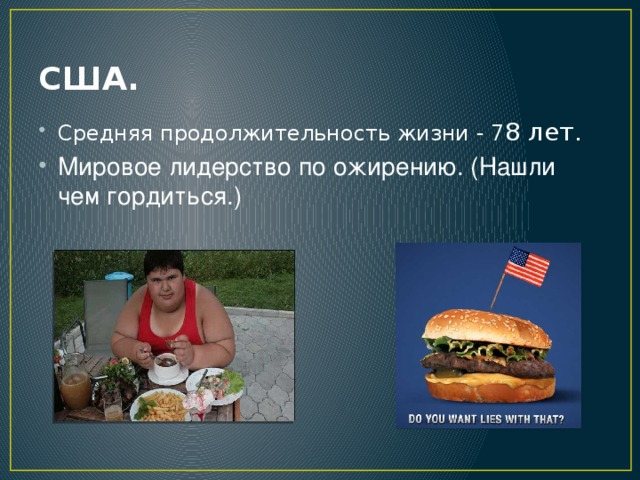
USA.
- Average life expectancy is 7 8 years.
- World leadership in obesity. (We found something to be proud of.)
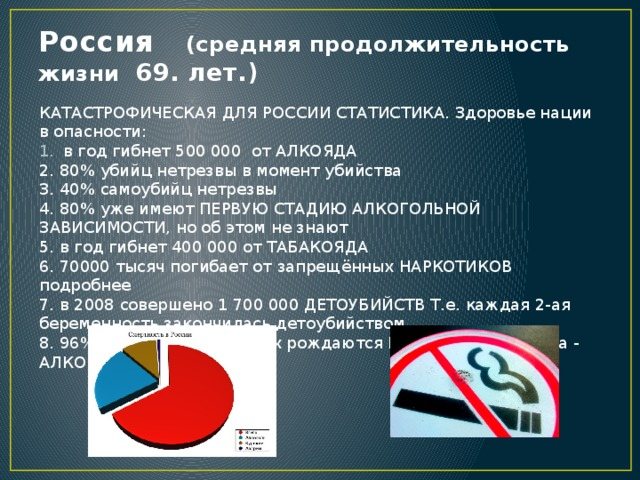
Russia
(average life expectancy 69 years.)
CATASTROPHIC STATISTICS FOR RUSSIA. The nation's health is in danger:
- 500,000 die per year from ALCOHOL
2. 80% of murderers are drunk at the time of the murder
3. 40% of suicides are drunk
4. 80% already have the FIRST STAGE OF ALCOHOL DEPENDENCE, but don’t know about it
5. 400,000 die per year from TOBACCO POISON
6. 70,000 thousand die from illegal DRUGS read more
7. in 2008, 1,700,000 infanticides were committed i.e. every 2nd pregnancy ended in infanticide.
8. 96% of Russian children are born SICK, the reason is ALCOHOL!!

Caucasus
- The Caucasus is home to 42% of all inhabitants of the planet who have reached one hundred years of age or more, and the Caucasus region has currently been studied most fully. The secret of “Caucasian longevity” is determined by a complex of reasons: the presence of mountain air, healthy nutrition, the peculiarities of the lifestyle of the mountaineers and, probably, first of all, their spiritual qualities.
Russia ranks
131 out of 192 countries in terms of life expectancy.
- A person’s life expectancy is determined not only by his biological and hereditary characteristics, but also by social conditions (life, work, rest, nutrition). Some people are known to live to be 110 years or more. Average life expectancy is a variable value: it indicates the efforts of society aimed at preventing mortality and improving the health of the population. In economically developed countries, the average life expectancy has now reached 70 years.

Thank you for your attention.
Bad habits
What is a bad habit?
A bad habit is an action that is automatically repeated many times, and this action is harmful from the point of view of the public good, others or the health of the person himself who has fallen under the bondage of the bad habit.
Bad habits include the following:
- Alcoholism
- Addiction
- Smoking
Smoking, drugs, excessive alcohol consumption are those bad habits that have a detrimental effect not only on the health of the direct consumer, but also on the quality of life of the people around him.
Alcoholism is the most common bad habit, often turning into a serious disease, characterized by a painful addiction to alcohol (ethyl alcohol), with mental and physical dependence on it, accompanied by systematic consumption of alcoholic beverages despite the negative consequences.
Drug addiction is a chronic progressive (development of the disease with increasing symptoms) disease caused by the use of drug substances. Different drugs cause different addictions. Some drugs are highly addictive psychologically but not physically addictive. Others, on the contrary, cause strong physical dependence. Many drugs cause both physical and psychological dependence.
Smoking is the inhalation of smoke from drugs, mainly of plant origin, smoldering in the flow of inhaled air, in order to saturate the body with the active substances they contain through their sublimation and subsequent absorption in the lungs and respiratory tract.
Sociological research (questionnaire)
In order to refute or accept the project’s hypothesis, I invited students to answer questionnaires that included questions covering all aspects of a healthy lifestyle:
Questionnaire No. 1 “My idea of a healthy lifestyle”
Questionnaire No. 2 “My physical activity”
Questionnaire No. 3 “Proper nutrition”
Questionnaire No. 4 “Personal hygiene”
Questionnaire No. 5 “Bad habits”
24 students in grades 8-9 took part in the survey.
Survey results. My idea of a healthy lifestyle
Of the 24 respondents, 23 were able to accurately formulate what the concept of a healthy lifestyle means and what needs to be done to lead a healthy lifestyle. This fact proves the correctness of the first part of our hypothesis - Teenagers can competently explain what the concept of a healthy lifestyle includes. To the question “Do you think the following statement “I lead a healthy lifestyle” is true for your lifestyle? 23 respondents answered - no, one I don’t know.
My physical activity Based on the results of questionnaire No. 2, we can confidently say that the daily routine of the respondents does not correspond to the norm. They spend little time walking (mostly because they don’t have time; some only go for walks on weekends), and they sleep little. They spend a lot of time watching TV, computers, doing homework and extra classes in subjects.
All 24 respondents do not do morning exercises, citing the fact that exercises are carried out at school before the first lesson. It is also indicative that only 3 respondents attended all physical education lessons in the first half of the year; the majority missed more than 10 lessons due to illness. In winter, schoolchildren do not ski at all (only during physical education lessons); 50% of respondents skate at least once a week (although conditions have been created for this in the village).
As for summer active recreation, we can say that the time of the bicycle has long passed. Only 3 out of 24 respondents ride a bicycle at least 3 times a week; many do not recognize this type of active recreation at all. Analyzing the data, we can say with confidence that physical activity in adolescents is low and the daily routine of a modern teenager cannot be called correct.
Proper nutrition From questionnaire No. 3, we conclude that 50% of children do not have breakfast at home, eat dry food, drink a lot of carbonated drinks, crackers, chips, and sweets. Only 4 people eat first courses at lunch, they do not consume dairy products and fruits every day, and they eat few vegetables. When buying products, almost everyone does not think about their benefits or harm. All respondents understand that they are eating incorrectly.
Personal hygiene All 24 respondents know the rules of personal hygiene, and according to the questionnaire, 20 respondents fully comply with all the rules of personal hygiene, only 3 people do not always have time to do everything correctly (brush your teeth in the evening, wash your face before going to bed), 1 person could not give an answer to this question.
Bad habits Data from the Bad Habits questionnaire show that slightly less than 50% of respondents have tried smoking and drinking alcohol, with 3 people smoking (not constantly), 2 people drinking alcohol on holidays. The majority of respondents indicated that smoking and drinking alcohol can only be done from the age of 18; using drugs is prohibited from any age. The good news is that none of the respondents have tried drugs and consider it unsafe.
After processing the questionnaires, we concluded that almost all students do not follow the rules of a healthy lifestyle.
It is imperative to carry out work to promote a healthy lifestyle, proper nutrition, and the prevention of bad habits.
The results of questionnaires No. 2 - No. 5 prove the correctness of the second part of the hypothesis - there is practically no child who fully complies with the rules of a healthy lifestyle.
In our case, almost all teenagers do not comply with the motor regime, work and rest regime, do not eat properly, only two indicators - personal hygiene and bad habits - 90% of respondents comply with the rules of a healthy lifestyle. And it is necessary to carry out work to prevent bad habits so that those respondents who have already tried smoking and drinking alcohol do not have a desire to do so again.
Conclusions based on the results of the project
In the course of working on the project and analyzing the results of the sociological study, we can say with confidence that the hypothesis was completely justified. Indeed, teenagers can competently explain what the concept of a healthy lifestyle includes, but there is practically no child who fully complies with the rules of a healthy lifestyle.
Following the norms and principles of a healthy lifestyle is the duty of every reasonable person. A conscious attitude towards one’s own health should become the norm of behavior, the main distinguishing feature of a cultural, civilized personality.
Quality of health concerns all aspects of life. This is why developing a healthy lifestyle is of great importance. It can only be achieved by creating permanent habits. This will not take a day or two. If you really want to start taking care of your health, be patient. Where to start?
I have prepared a booklet for those who want to start leading a healthy lifestyle and I think it can become instructions for every schoolchild and even adult.
Social project “We are for a healthy lifestyle”
Municipal state educational institution
"Bogucharskaya secondary school No. 1"
social project
"We are for a healthy lifestyle!"
Project Manager:
class teacher of 8th grade
Alabina Galina Yurievna
Project implementers:
8th grade students
Project type:
Long-term, group, research,
creative, interdisciplinary.
Project timeframe:
2015-2016, 2016-2017 academic year.
The problem that the project aims to solve.
Our future depends on today's graduates, on their physical and moral health. But over the years of school, the health of many children deteriorates. Negative trends have emerged for a number of indicators: the number of children with chronic diseases is increasing. Children's alcoholism and drug addiction, as well as the large number of schoolchildren who smoke, are of concern. Involving students in the implementation of the project will help to correctly solve the problem of free time, form a negative attitude towards bad habits and realize responsibility for their own health.
The project program should orient the child to form a position
recognition
of the value of
health, a sense of responsibility for maintaining and strengthening one’s health, expanding knowledge and skills of a health culture, and developing the habit of a healthy lifestyle.
Objective of the project:
promotion of
a
healthy lifestyle , education and formation of a responsible attitude towards maintaining health as the most important human value.
Project objectives:
- Formation of the need for a healthy lifestyle and responsibility for one’s health;
- To promote a healthy lifestyle using the example of the school’s best students and their achievements in various fields of study, creativity and sports.
- To form in students a stable negative attitude towards tobacco, alcohol, and drugs.
- Create a subject-development environment that provides the emotional mood of students and conditions for organizing physical activity.
- Foster a culture of exchange of opinions, develop the skills of ordered, structured thinking.
- Foster children's need for daily personal hygiene.
- To form ideas about the beauty of the natural world, about the positive and negative effects of human impact on the earth’s atmosphere.
- To foster citizenship, hard work, respect for human rights and freedoms, love for the environment, the Motherland, and family.
• Hypothesis:
The process of introducing children to a healthy lifestyle will be more effective and productive if the implementation of the idea and concept of the project is carried out with the help of TSO funds; artistic and illustrative material; conversations; observations; excursions; productive activity.
Relevance of the topic
.
At the present stage, the problem of preventing children's health is one of the most pressing.
At school age, as a result of targeted pedagogical influence, health, vital activity and other qualities necessary for the comprehensive, harmonious development of the individual are formed.
Valueological education is impossible without studying the structure of the human body. Our many years of experience in pedagogical work have shown that in addition to creating favorable conditions for the development of a healthy child, it is necessary to form a new “layer” of knowledge in valeology among schoolchildren and help introduce children to a healthy lifestyle using innovative technologies.
The problem of protecting children's health at school is very acute. An analysis of the health status of our students showed that in the classroom the key to children’s well-being is physical development, hardening, and disease prevention.
The child’s body grows and develops rapidly, and the values of a healthy lifestyle are laid down.
The formation of a child’s health at school age largely depends on what work is done in this direction at school. It is necessary to create an emotional, joyful environment, since the health of children largely depends on their mental state. The organization of space at school is of great importance. A properly organized developmental environment gives a child the opportunity to express himself socially, learn certain rules of a healthy lifestyle, feel connected with other children, and strengthen self-confidence. And then our children will be physically healthy, active, and sociable. Considering all of the above, we faced the need to develop and implement a project to promote a healthy lifestyle using modern educational technologies.
• Degree of development of the problem:
The teaching aids that exist today do not sufficiently develop students’ knowledge about a healthy lifestyle. Therefore, I decided to reveal it more fully with the help of the created project.
• Project activity object:
The process of introducing children to a healthy lifestyle.
• Subject of project activity:
Innovative technologies; design method; conditions created for the project.
An important condition for the spread of a healthy lifestyle is an increase in the number of adolescents striving to maintain and improve their own health and have an active social position.
At the same time, it is important to provide ways of social activity that allow students to take action to promote health among their peers.
Main method
is a research work during which the children themselves conducted the research, processed the results and presented them in the form of diagrams, drawings, and presentations. While implementing the project, participants learn to use various sources and methods of obtaining information. This project was developed with the aim of introducing schoolchildren to a healthy lifestyle. The project involves increasing the level of awareness about the activities of children's institutions in the city of Boguchar, which provide the opportunity to actively and usefully spend free time and develop the creative abilities of students. The project promotes the formation of a negative attitude towards alcohol, smoking, drugs, provides an opportunity to gain knowledge about proper nutrition, informs about cardiovascular diseases and their prevention, strengthening the body and protecting human health in the Russian Federation. The project teaches schoolchildren to provide first aid in case of an accident.
Working together in a group promotes team unity, mutual understanding grows, and responsibility not only for one’s own activities, but also for the work of the entire group. The project stimulates schoolchildren to be active in completing the task, develops interest in the problem, and independence.
We will promote a healthy lifestyle and sports under the motto:
The smart choice is the right decision.
When creating the project, we relied on the following principles:
- Health is a priority. Everything makes sense as long as we are healthy. Your health is in your hands.
- Health is not everything – but everything is nothing without health.
- Deliberately harming your health is stupid. Declare war on bad habits.
- Without bad habits you can get much more out of life.
- Physical and psychological health are inseparable. Choose an active life position: find yourself in sports, creativity, study. Don't be indifferent! Help those who are in trouble.
- Follow the example of the best.
- All the best qualities develop where there is a creative attitude towards life.
According to medical experts, the age from one year to 15 years is much more important for maintaining future health than from 15 years to 60.
It is this circumstance that prompted research activities in this area in order to determine the conditions for maintaining the health of students.
Considering the relevance of the area, this project can be continued and expanded. This project can be used or taken as a basis by class teachers of any class to organize extracurricular activities.
Expected results
- Reducing morbidity, resistance to stressful situations, maintaining and strengthening the health of schoolchildren.
- Improving the health status of schoolchildren, reducing absenteeism, improving the quality of their knowledge.
- Employment of children outside of school hours (clubs, sections, etc.)
- Students' awareness of the need to spend their leisure time wisely.
- Increasing the attention of schoolchildren and their parents to health issues and a healthy lifestyle.
- Forming in students an idea of common human values and a healthy lifestyle.
project implementation
- Conducting a survey among students in grades 8b, 11a
QUESTIONNAIRE “WHAT DO YOU KNOW ABOUT A HEALTHY LIFESTYLE”
Dear friend! Please take this form seriously and answer all questions, highlighting your chosen answer with a straight line. If you are not confident in your knowledge on a particular question, then underline the answer with a wavy line or add your answer. Two or more answers may be underlined. Your gender: male, female What is your age? …………………….years 1. Is your life interesting?
-Yes -No -Mediocre - Other... 2. What are your hobbies in your free time?
-Sport -Literature -Music -Technology -Computer -Other...
3. Do positive emotions influence the improvement of your health?
-Yes -No -Difficult to answer
4. Are you satisfied with the socio-psychological climate in your educational institution?
-Yes -No -More likely yes than no
5. How active are you in physical education and sports?
-Constantly -Occasionally -I don’t practice
6. What sports sections and clubs did you take part in?
__________________________________________________________________
7. Have your educational institution created conditions for physical education and sports?
-Yes -No
8. Do physical education and sports affect your health?
-Yes -No -Difficult to answer
9. Do you harden your body?
-Yes -No -I don’t think it’s necessary
10. Do you consider maintaining personal hygiene an important condition for a healthy lifestyle?
-Very important -Somewhat important -Somewhat unimportant -Not at all important
11. Do you smoke?
-Yes -No -Occasionally -Up to 10 cigarettes a day -More than 10 cigarettes a day 12. Why do you smoke
?
- Having nothing to do - Seeming more mature, independent
13. Do you know how smoking affects your health?
-Harmful to health -Good for health -Difficult to answer
14. Is smoking harmful to surrounding non-smokers – “passive smoking”
-Harmful
-Not harmful
-I find it difficult to answer
15. Should you quit smoking to be healthy?
-Yes -No I don’t know
16. Have you tried alcoholic drinks?
-Not really
17. Do you drink alcohol?
-Not really
18.If “yes”, how many times (approximately) do you drink?
Per week: one, two, three or ……….times Per month: one, two, three or …………times
19. Is drinking alcohol dangerous for your health?
-Yes -No -I don’t know
20. Have you and your friends used any intoxicating pills or chemicals?
-Not really
21. Have you heard anything about the health hazards of taking pills and other chemicals?
-Not really
22. To what extent are you familiar with the problem of drug addiction among young people?
-Totally -To some extent -Almost familiar or not at all familiar -Never interested in these issues
23. Have you encountered problems with drug use?
-Yes, I tried it several times -Yes, 1-2 times -Yes, I had a friend who was a drug addict -Yes, in my own family -Yes, in the family of friends or acquaintances -Fortunately, I never encountered
24. In your opinion, is balanced nutrition an integral part of a healthy lifestyle?
-Yes -No -I don’t know
25. Do you agree that rational nutrition is:
- balance between the energy supplied by food and the energy consumed by a person during life, in other words, energy balance - meeting the body's needs for a certain amount and ratio of nutrients - adherence to a diet (certain meal times and a certain amount of food at each meal)
26. Do you follow any special diet?
-Refusal of meat products -Separate meals -Refusal of baked goods -Therapeutic fasting
-Other……………………………..
27. Do you eat in the canteen?
-Not really
28. Are you satisfied with the catering arrangements in the educational institution?
-Yes -Not really -No
29. What would you like to change in the catering organization of educational institutions?
-Daily menu -Meal schedule -Food preparation technology -Product range -Service -Other …………………………… 30. In your opinion, a healthy lifestyle is…?
-Giving up bad habits -Personal hygiene -Optimal motor mode -Rational nutrition -Hardening -Positive emotions -Physical training and sports -Proficiency in safe behavior skills
31. Why would you lead a healthy lifestyle?
-so as not to be bothered by illnesses;
- to live long;
-to look beautiful;
- to achieve everything in life.
32. What circumstances could prompt you to change your lifestyle?
—
example of parents;
-an example of people I respect;
-diseases;
-visual information in facts and figures;
33. What lifestyle, in your opinion, is attractive and prestigious?
___________________________________________________________
Comparative analysis of questionnaires.
- Proper nutrition
Total respondents: 21
- Conducting a survey among parents.
Questionnaire for parents
"Healthy lifestyle in the family"
1. “Healthy lifestyle” – how do you understand this?
- Proper nutrition
- Maintaining a daily routine
- Favorable environmental conditions
- Harmonious family relationships
- Physical education classes
- Other _________________________
2. What factors, from your point of view, most influence your child’s health?
- Environmental pollution
- Hereditary diseases
- Insufficient level of physical activity
- Poor nutrition
- Bad habits
- Other _____________________________
3. Assess your child's health?
- good
- Bad
- I find it difficult to answer
4. Has your child been sick often during the year?
- Yes, (_______) times?
- No
What do you see as the causes of diseases? ___________________________
5. How do you spend your weekends with your child?
• ____________________________________________
6. Is there a daily routine for your child at home?
- -Yes
- -No
7. Indicate the types of activities your child does at home (Weekdays, (evenings), weekends)
- Computer classes
- Outdoor games
- Hiking with parents
- Watching TV
- Exercise
- Other___________________________
8. What measures are you taking to improve your child’s health?
- Visiting doctors
- Exercise
- Hardening
- Breathing exercises
- Massage
- Walks in the open air
- Proper nutrition
• Other _____________________________________________
9. How often do you pay attention to improving your child’s health?
- Regularly
- From time to time
- I don't pay any attention
- Other __________________________________________
10. When was the last time you checked your child’s health?
a) this month b) this half-year c) this year d) I don’t remember
11. Which members of your family go in for sports?
a) constantly (who?) b) often c) rarely d) don’t do it at all
12. Does your family lead a healthy lifestyle?
a) yes b) partly c) difficult to answer
13. Where do you get knowledge about a healthy lifestyle?
a) from special books b) from the media c) from conversations with .... (by whom?)
14. Do you use hardening in your family, and what types?
a) regularly…… (what?) b) not always…….(what?) c) occasionally d) too busy, no time
15. How do you instill a healthy lifestyle in your children?
a) through conversations b) by personal example c) together d) difficult to answer
16.How do you feel about drinking alcohol?
a) I consider it unacceptable
b) moderate use is possible during the holidays c) this is unacceptable in the presence of a child d) I don’t consider this a problem
17. How do you feel about smoking?
a) this is a bad habit b) this is unacceptable in the presence of a child d) I don’t consider this a problem
18. Do you or other family members have any bad habits?
?
- Yes,
- No
19. Do you consider your diet rational?
a) yes b) no c) partly d) difficult to answer
20. What health-improving activities do you carry out with your children at home?
a) attend sports clubs b) ski, skate, bike, rollerblade, etc. c) other events
21. What physical education equipment and sports equipment do you have at home (for adults and children
)
________________________________________________________________________________________
22.What difficulties do you experience in organizing your child’s health?
a) have no knowledge
b) there are no means for recovery
c) no time
23. Who do you think should do the most to improve the health of children?
a) school
b) parents
24.
Do you do morning exercises?
- Yes
- No
- Sometimes
Processing parent questionnaires.
Results of the project
"We are for a healthy lifestyle!"
During the 2015-2016 academic year, school students took part in the implementation of the socially significant project “We are for a healthy lifestyle!” The work was carried out outside school hours, during circle work hours.
After completing the project, students were able to:
- name healthy foods;
- show how to sit at the workplace correctly;
- measure your blood pressure yourself;
- name the commandments of health;
- name medical specialists who treat certain diseases;
- name proverbs, riddles, fairy tales and poems about healthy lifestyle;
- acquired group interaction skills and the ability to work in a team;
- acquired abilities, knowledge and skills that allow them to comprehend their place in the world, the choice of value, target, and semantic attitudes for their actions;
"The Ten Commandments of Health, or the Recipe for Longevity"
- Daily regime
- Daily morning exercises
- Healthy eating
- Walks in the open air
- Full sleep
- Sports activities
- Clothes for the season
- Less stress, more humor
- Live in peace and harmony with your family
- Down with bad habits
Considering the relevance of the area, we will continue and expand this project
